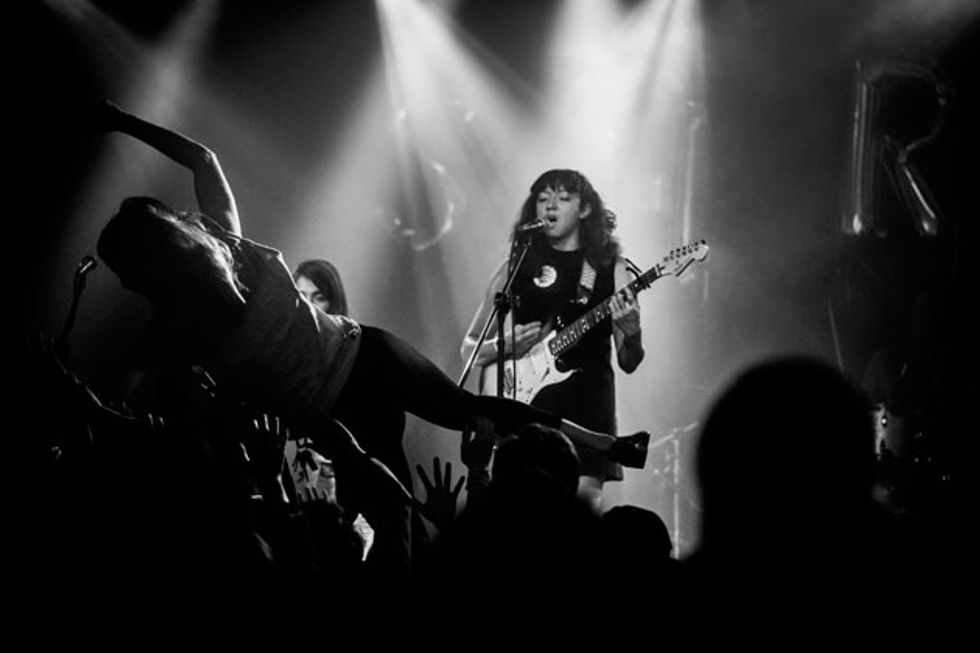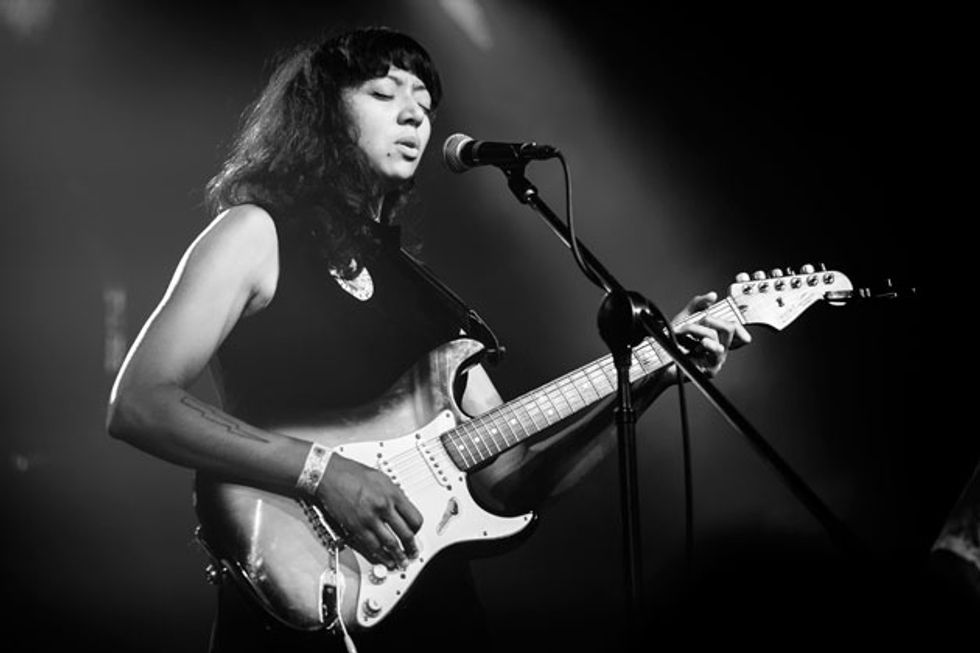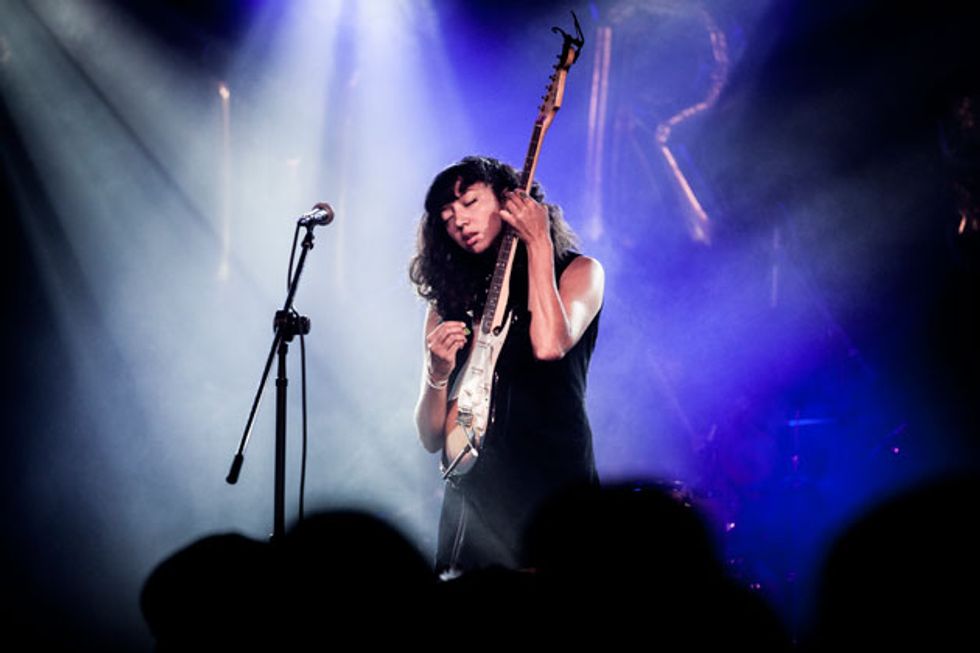Perhaps the most difficult rabbit to pull out of any musical hat is to wring something fresh, truly vital, and contemporary from the bones of a form already steeped in its own history. Authenticity, especially in the ultra-romanticized genres of guitar music, is no small undertaking. Neither is the quest to say something new and relevant that draws heavily from revered, iconic, historic sounds.
Does the charm in retro guitar music live in the music itself or in the nostalgia it evokes? Regardless, these styles are iconic for a reason, and when a contemporary artist does make a unique statement using classic textures, tones, and ideas, it’s usually a particularly compelling one. Seattle’s heiresses to the surf-rock throne, La Luz, have provided a testament to this with the release of their sophomore LP, Weirdo Shrine, a lushly adorned, energetic adventure of an album that fuses surf-guitar, girl-group harmonies, and dark, eerie organ in a way that provides a modern take on a vintage vibe with conviction, sidestepping the irony that plagues most surf-rock bands.
Led by guitarist/frontwoman Shana Cleveland and rounded out by Lena Simon on bass, Alice Sandahl on keys, and Marian Li Pino on drums, La Luz is a gem amid the sea of myopic, reverb-slathered, kitschy garage-rock currently riding the wave of the psych-rock revival. The band’s songs are rife with lyrical depth and an honesty that delivers La Luz’s music far from the novelty surf and shines a new light on the genre as something more than a vehicle for fun guitar playing, though instrumentals like the barreling “Hey Papi” make sure there’s still plenty of fun guitar-fiber lurking in the depths of La Luz’s surf-noir sound to keep you on your toes.
We spoke with Cleveland about her journey into the heart of surf guitar, her influences as a player, and why La Luz is more than the band’s genre-label might put on. Added bonus: Read “Everything in Between” sidebar to hear bassist Lena Simon’s approach to La Luz’s low end.
How did you get into surf music?
I saw this band called the Diminished Men play right after I moved to Seattle. They’ve been around Seattle for maybe a decade, and they’re this really great, dark, strange surf-rock band, and I saw them play at a house show. The show was just so much fun, and I don’t think I’d even consciously listened to surf music prior to that, but I was just so blown away by them that it sparked up this serious desire to be in a band like that. In fact, I was in another band at the time and I eventually just came to the conclusion that I had to learn to play like the Diminished Men and was done with the band I was in.
La Luz guitarists/frontwoman Shana Cleveland jams on her MIM Fender Stratocaster she bought at a small music shop in Seattle called the Trading Musician. "I’m not a gearhead by any means, so any time I need something, I tell the people working there the sound that I’m after and they’re cool with me doing some trial-and-error, so that’s how I’ve come
by most of my stuff," says Cleveland. Photo by Sam Gehrke
Which players influenced you the most when you started getting into surf music?
A big one for me, especially since I started playing with La Luz, is a Japanese guitarist named Takeshi Terauchi, who was in a band called the Bunnies back in the ’60s. That band put out an album, that I believe has been re-released recently, called Nippon Guitars, and that record and his playing has become really my major guitar influence these days. Definitely Link Wray, too. When I first started trying to play surf guitar, I started by trying to figure out how to play his songs.
How did you go about learning to play the style?
It was kind of ridiculous, actually. I had this Link Wray compilation—an actual vinyl record—and I’d pick out a couple of songs a day and sit there moving the needle back over and over again. It would take me like an hour to learn 10 seconds of what he was doing, so it was a ridiculous, super tedious way of learning. But it ended up being a great way to learn because, while it was a lot of work, it was so exciting and rewarding when I would finally figure something out. What I love about that style—and I think this is probably true about any style of guitar playing—is there is just so much you can do with one note in surf guitar. Link Wray in particular used so many tricks and ways to approach playing any one note, whether it was a hammer-on, or a slide, or a bent string, and learning those parts by ear was really satisfying for me.
That’s the only way I’ve ever tried to learn, honestly. I don’t have much patience for things like YouTube tutorials, and I’m not sure if other ways are better or not, but this is what works best for me.
Your playing sounds like someone that has studied the genre deeply. Are you at all focused on authenticity when writing your guitar parts?
No, not really. I really admire a lot of those players and the people who crafted that sound and I certainly try to copy them to some extent, but I mostly feel out of control when I go to write my own music. I don’t know that I’m capable of creating a true reproduction of that style, though it’s cool to hear that it sounds authentic. I think a lot of that lies in the tonal choices. I try not to go for a super clean, modern-sounding tone.
During the sessions for Weirdo Shrine, producer Ty Segall gave La Luz guitarist Shana Cleveland her first fuzz pedal, a Death By Audio Fuzz War. “I’d never used fuzz before and now I really dig it,” she says. Photo by Sam Gehrke
I think it also has something to do with the fact that what I mostly listen to is so guitar-centric, and not just surf guitar, but really any guitar playing from the late ’50s and ’60s. There was sort of this one style of sick electric guitar playing that people did across so many genres during that time. There was a lot of really great country lead guitar in that era that was similar in a lot of ways to a lot of surf lead guitar, and even in the soul music and Asian rock music from that time. So it’s got a lot more to do with my listening interests being so focused on that early rock ’n’ roll, riff-heavy lead style than directly striving for authenticity in my own playing.
The tones on the album are fantastic. Did Ty [Segall, producer] bring in any particularly cool gear to track guitars with?
We pretty much used my stage rig, but I played through one of Ty’s amps, though it was just the amp that he had that I felt got the closest to my own amp’s sound. It was a ’70s Fender Super Six Reverb. Ty did have some cool, unconventional ideas about how to EQ my amp. Early on, he goes “Turn the treble all the way up!” and I said “Are you sure about that?!” But it worked out really well and it’s actually very close to how I sound live.
Tracking this album was also the first time I used a fuzz pedal, which Ty let me borrow to record with and then gave me after we finished the album. That’s a Death By Audio Fuzz War. I’d never used fuzz before and now I really dig it.
—Shana Cleveland
What guitar did you use to track the record?
The same Mexican Strat that I’ve been playing for a long time.
How did that guitar come into your life?
Like most of the gear that I have, I bought it at a small music shop in Seattle called the Trading Musician. I’m not a gearhead by any means, so any time I need something, I tell the people working there the sound that I’m after and they’re cool with me doing some trial-and-error, so that’s how I’ve come by most of my stuff. It was recommended to me as a really good guitar for the money for the sound I was going for, so I went with it and I absolutely love it!
What was it like working with Ty?
The coolest thing for me was that his approach to recording was really close to how I always wanted to record, but never had the chance to, which is almost entirely live and willfully letting go of some of the controllable factors in the process. Things like using a lot of room mics and recording all of the instruments in the same room without sound barriers to keep things from bleeding. That appeals to me much more than trying to tightly control the sound of everything. I’m always seeking to get the most live sound I can.
I’ve read that the album was tracked in an actual surf shop. How did that happen?
It wasn’t our intended location, but we needed to find a new spot to track at the very last minute and Ty’s buddy Tyler shapes surfboards in a warehouse in San Dimas and volunteered the use of his space. So a bunch of the guys from Ty’s band came and helped us clear everything out and move all of his recording equipment into the surf shop and we just camped out in there for a week!
Shana Cleveland’s Gear
GuitarsLate ’90s Mexican Fender Stratocaster
Amps
Late ’70s Music Man HD-130 combo
Effects
’60s Gibson Reverb III outboard reverb
Death By Audio Fuzz War
Custom delay pedal built by Tyler Venture at the Trading Musician in Seattle
Boss TU-2 ChromaticTuner
Strings and Picks
Various brands (.010–.046)
Dunlop .88 mm
A lot of bands these days toy with surf-rock textures and use a ton of reverb on what I think boils down to pretty average garage-rock, but few of them really go all the way or try to say something new within the form. Do you have an opinion on that trend at all?
That was a big thing that made me want to start this band. I kept reading descriptions of bands with “surf guitar” and surf/whatever bands, and they’d never sound anything like that. I’d always be let down by these bands and they all sounded like each other and I felt like it was a style that really was lacking and it was something I really wanted to hear more of, and I really wanted to combine it with tons of vocal harmonies.
There is quite a bit of darkness to the band’s sound and I’ve heard people refer to it as “surf-noir.” Where does that element come from?
It’s not something that I set out to do at all, but it definitely comes through in a big way and it’s one aspect of the band that receives a lot of discussion. Actually, we’ve been touring in Europe for the last month and there was a review of our show in Glasgow and The Guardian referred to us as “doom-wop,” which I found pretty appropriate.
The most exciting songs to me are songs that have the sort of duality and an element of darkness to them. If it’s a love song, real love is scary and sad at the same time, and intense sadness is horrible, but it puts things in perspective and there’s always a duality that I’m more interested in.
Aside from that, I was going through some very heavy things when I wrote the first album. There was a mass shooting in Seattle and some friends of mine were killed. That was really weighing heavily on my mind at the time and death just kept cropping up, and I think death is something that will always crop up no matter what you’re doing in life, so it seems natural for it to be a part of my writing.
Do you ever intersect that niche world of neo-surf guitar, where most of the people involved wear era-specific clothing and are Dick Dale clones?
It’s weird how rarely we intersect that world, really. We’ve only ever performed with a few straightforward surf bands, and none of them have been the big costume/big attitude type of bands. They’ve been more in the realm of party bands that happen to play that style because it’s a fun genre, but not many surf original bands. A lot of the bands we play with have a bit of surf influence, but are not as obsessed with it as we are, like Guantanamo Baywatch, who I think of as a surf band, but there are country and punk-rock elements to what they do. I’m not sure what the purists would really think of us?
YouTube It
La Luz enchants with a performance of “Sleep Till They Die” on KEXP. Note the four-part vocal harmonies throughout, and a tasteful solo by Shana Cleveland at 2:50.
Is it ever an issue writing guitar parts that jive well with the keyboards without taking up the same sonic space?
No, but it’s something we’re still figuring out as we go. I’ll usually write a full song and then we figure out as a band where we’ll take our respective solos, but we don’t put too much premeditated conscious thought into it—we just jam it out typically.
“Hey Papi” to me stands out as a big moment in the record for you as a guitarist. What does the song mean to you?
That song was just me really wanting to write a song for Marian [Li Pino] to go crazy on. A lot of the instrumentals I’ve written are really focused on my guitar melody and I wanted one that focused more on some heavy drumming. Putting the vocal harmonies on the end of it was a great touch because it’s a more macho song than we’d normally play and having a four-part female harmony on the end balances it really well.
Do you ever wonder if identifying as a surf band will be a disservice if you ever break out of that sound?
It didn’t occur to me at all when we started playing, but since then I’ve noticed little inklings of that being a reality. I feel like sometimes we’re not taken seriously because we have the surf label, and I feel that surf as a genre is a bit of a dirty word in some way, where people hear the term and automatically think it’s a gimmick or a novelty, but I hope it doesn’t become a detriment. Everyone has to pick a couple of words to describe themselves and it’s unfortunate that one genre label might be limiting to you in the way another label wouldn’t be. I feel that we’re also a pretty new band, so I feel that, hopefully, any labels and stigmas only remain as an introduction and fall away when we release more work.
Lena Simon’s bass approach is to be the glue between the melody, harmony, and rhythm. “I play with flatwound strings and palm mute with a pick,” says Simon. “That’s the secret right there. Playing-wise, I want my picking to match the kick drum’s timbre and my notes to be an extension of the drums.” Photo by Sam Gehrke
Everything in Between: Lena Simon’s Low-End
As the bassist of La Luz, Lena Simon is chiefly responsible for the locomotion of the band’s often high-velocity songs, but she also provides an important counterpoint for guitarist Shana Cleveland’s adventurous guitar work. She tells us about her role within the band’s subtly complex arrangements, her killer tone, and which players she admires most.
How deep were you into surf music before joining La Luz?
Surf music wasn’t really a genre I had explored much before joining La Luz, at least not in its authentic form, like what guys like Dick Dale and Link Wray did. But I’ve always been a fan of old rock ’n’ roll, soul, and ’60s girl groups. When I heard La Luz that’s more of what I jumped to than the whole surf thing. I definitely feel more knowledgeable about surf than I did before, and with that, a deeper appreciation for it, but I wouldn’t say it’s ever become an obsession.
Do you take influence or queues from any particular bass players or bands?
I’m always a fan of players who use the whole instrument, but can tell when to take on a supportive role and when it’s time to do something flashy. Bands like the Growlers use a lot of bass melodies, and the bassist from the Shivas, Eric Shanafelt, can play a ton of notes and still somehow not sound like he’s playing too many, and I think he’s amazing.
Three mistakes, do it again.’” —Lena Simon
Of course, Paul McCartney is a master at composing very thoughtful bass lines and, more recently, I’m really into the bass work on Tame Impala’s records. Bass really is the glue between melody, harmony, and rhythm—so anyone who can marry all three can count me as an admirer.
You do a lot to keep things moving under what Shana plays. How do you approach writing your parts?
I’m not the original bass player of La Luz. Abbey Blackwell was and she’s a killer bassist. Learning her parts from the first album, It’s Alive, definitely made me a better bassist and gave me a lot of insight on how to play with this band. When we started writing Weirdo Shrine, I remember thinking that I wanted to introduce a lot of straight-ahead groove parts to make things a little thumpier. With Shana being both the lead singer and the only guitar in the band, she often has to alternate between leads, rhythm parts, and solos. My job is to decide when to fill the gaps between her notes or strumming and when to simply support them. For example, the opening of “You Disappear” is a fast picking, unison bass and guitar melody where I then split off and play rhythm while she finishes the melody. On the other hand, “With Davey” required a more rhythmic role from me for the majority of the song, where the groove is like its own melody. So I’m a little more active than, say, a bassist in a band with two guitars, for example.
Lena Simon’s Gear
BassesLate model Hofner CT Club Bass
Amps
Ampeg B200R Rocket Bass Diamond Series 1x15 Combo
Effects
Black Cat Bass Octave Fuzz
Boss TU-2 Chromatic Tuner
Strings and Picks
La Bella short scale flatwounds (.045–.105)
Dunlop Tortex 1.14 mm
Your bass tone works really well against Shana’s guitar sound. How do you go about getting that particular thump and percussive quality?
It’s all about getting a nice round low end with a bright attack and everything in between works around those two points. I play with flatwound strings and palm mute with a pick. That’s the secret right there. Playing-wise, I want my picking to match the kick drum’s timbre and my notes to be an extension of the drums.
What was it like working with Ty Segall?
Ty is the sweetest, most prolific guy. We wanted a very live sound for Weirdo Shrine and the warehouse where we recorded really helped to shape that. When we were recording, Ty only had one guideline that really stuck with me: “One mistake, still good. Two mistakes, maybe (but probably still good). Three mistakes, do it again.” I think this was Ty’s way of keeping it a truly live record. It’s thrilling if you mess up, and we kept a lot of the mistakes, which I like—they add a lot of character to the album.

















![Rig Rundown: Russian Circles’ Mike Sullivan [2025]](https://www.premierguitar.com/media-library/youtube.jpg?id=62303631&width=1245&height=700&quality=70&coordinates=0%2C0%2C0%2C0)
















![Rig Rundown: AFI [2025]](https://www.premierguitar.com/media-library/youtube.jpg?id=62064741&width=1245&height=700&quality=70&coordinates=0%2C0%2C0%2C0)




















 Zach loves his Sovtek Mig 60 head, which he plays through a cab he built himself at a pipe-organ shop in Denver. Every glue joint is lined with thin leather for maximum air tightness, and it’s stocked with Celestion G12M Greenback speakers.
Zach loves his Sovtek Mig 60 head, which he plays through a cab he built himself at a pipe-organ shop in Denver. Every glue joint is lined with thin leather for maximum air tightness, and it’s stocked with Celestion G12M Greenback speakers.






